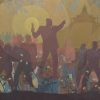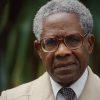By Stereo Williams
Prince’s death gutted music fans everywhere. The iconic musician became synonymous with music over a four decade-long career that challenged convention and championed freedom—and he became a benchmark for any artist who believes themselves driven by creativity and unwilling to relinquish control. But with his passing, there is something that needs to be stated, once and for all. Whatever your preferred genre of music—you need to understand something:
We just lost the greatest recording artist of all time.
The world is devastated, shocked, and stunned. The biggest icons in music, sports, and even the president of the United States reacted with sorrow and disbelief when it was announced that Prince had died. But this is more than just the death of a popular artist. We lost the gold standard for artistry. We lost the man who was the living, breathing embodiment of everything you could want an artist to be.
Prince’s humble beginnings in Minneapolis, living home-to-home after his parents’ divorce as he began writing and playing his own music around the city, was shrouded in secrecy and half-truths for much of his career. But his father forged his love of music and his mother encouraged his passions; and he began working with childhood friend Andre Anderson (aka Andre Cymone), eventually landing a management deal with businessman Owen Husney and a subsequent contract with Warner Bros.
His debut, For You, would be recorded in L.A. and released to little fanfare in 1978—although “Soft and Wet” would become an R&B hit. Prince was more fully formed on his self-titled sophomore album, moving past the futuristic disco-influenced funk of his debut for a more dense combination of funk, hard rock, and pop. It set the stage for what would be a decade of dominance.
In the 1980s, he released music at a relentless pace: nine official Prince studio albums, two releases from his funk-jazz side project Madhouse, three albums from the Time (which featured mostly Prince’s production and playing), the lone 1985 album from his Time follow-up The Family, various recordings by MAZARATI, another side project—plus bootlegs like The Black Album and scattered recordings from the abandoned, original 1987 Crystal Ball project. It’s an insane amount of content from an artist at his commercial peak—at which Prince certainly was from 1980 to 1989. In the midst of all that music, he was still touring, released two feature films (Purple Rain and Under the Cherry Moon) and managed to shepherd the career or contribute to hits by artists like The Bangles, Sheena Easton, Stevie Nicks, and Sheila E.
His list of musical collaborators has become a famous part of his legend; Andre Cymone, Doctor Fink, Bobby Z, Wendy Melvoin and Lisa Coleman, Dez Dickerson, Sheila E., Eric Leeds, Tommy Barberella, Rosie Gaines, Sonny T, Ida Neilson, Hannah Welton, and a host of others all contributed to Prince’s tremendous body of work at various points in his career. But there was never any doubt that his vision and creativity was what drove his art and performances. Prince was an entity unto himself and anyone who worked with him was pulled into his orbit.
He started the ’90s on just as much of a tear. He released the movie Graffiti Bridge and its accompanying soundtrack, the hugely successful Diamonds and Pearls album and Love Symbol Album within a two-year stretch. His battles with Warner Bros. famously curtailed his output after 1993, as he dropped his famous moniker for an unpronounceable symbol and released the music he wanted to release—as his former label churned out leftovers like Come and Chaos & Disorder. By 1996, he was finally free from Warner—and in true Prince fashion, his first release, the pointedly-titled Emancipation, was a triple disc, quasi-concept album. He followed it two years later with another triple album, named Crystal Ball but different in conception than the aborted project from the late 1980s. His commercial standing had slipped, but his artistic output never wavered and he didn’t seem to mind that Prince singles weren’t dominating the radio anymore. Prince’s muse was his music. Fuck if you like it. Fuck if the label likes it.
His personal life had always been a well-documented aspect of his intensely private public persona. His female companions have almost become the musical equivalent of “Bond Girls”: from Vanity to Apollonia to Susannah Melvoin to Susanna Hoffs to Carmen Electra—his infamous libido became almost as talked-about as his music. But with Prince, these women were never presented like ornaments or trophies—they were collaborators, muses, and peers. His adoration of women didn’t come across as hedonistic or exploitative; Prince related to women in a way that most male artists of his popularity and visibility never seemed to.
That persona—his willingness to tear down gender norms and traditional ideas of sexuality—became his calling card. In an era when rock stars were known for displaying women in cages and R&B singers mostly turned women into prizes to pursue, Prince offered a more complex, conflicted, and intriguing depiction of the sexes. He loved women. Women loved him. But he always made seduction a two-way affair, and, with songs like “If I Was Your Girlfriend,” he made it clear that he was just as willing to be his woman’s muse.
He was as prolific as anyone who’s ever set foot in a recording studio, as proficient as anyone who’s ever decided to pick up an instrument. He wasn’t satisfied with being a great singer—he was a great guitarist, great bassist, great arranger, and a brilliant producer. There is no one whose music saturated their peak period in the same way and delivered that music without a stellar set of musicians or a genius producer directing the show. The Beatles can’t say that. Michael Jackson can’t say that. Bob Dylan can’t say that. Even the genius of luminaries like Miles Davis and John Coltrane is linked to people like Sonny Rollins, Paul Chambers, Herbie Hancock, McCoy Tyner, Tony Williams, Ron Carter, Elvin Jones, and Jon McLaughlin—not to mention each other.
Prince stands as a unique figure, in that regard. A largely self-contained genius who was bursting with creativity. His musical influence stretches through everything since 1980, from the funk-rock riffs of Lenny Kravitz to the percolating beats of the Neptunes. You can hear Prince in Janet Jackson’s ’80s music (via her producers Jimmy Jam and Terry Lewis—former members of the Time and Prince protégés) and you can hear Prince in the INXS hits of the same period—with their combination of rock riffs and danceable grooves. Prince is everywhere.
Which is what made this news so hard for so many. We lost so much today because he’s given us so much for so long. He was always cool; showing up enough to maintain his visibility, but always allowing his mystique to define his public image. Fans know of his personal losses; the death of his newborn son in 1996 and his failed marriages were things that he chose to keep private—or at least as private as he could. But he never leaned on the public for his own sense of purpose or self. He trusted who he was. And we trusted him without demanding he show us more.
It’s a sad day for music. Because we’ve just lost the best. We’ve lost the artist who set the standard for what brilliance should mean. It should mean not giving a shit if your fans don’t always get it or if you release too much; and committing yourself to always delivering a stellar performance for anyone who sees you on a stage. It means loving music like it’s the only thing in the world that matters.
There will never be another one like Prince Rogers Nelson. The beautiful ones you always seem to lose.















